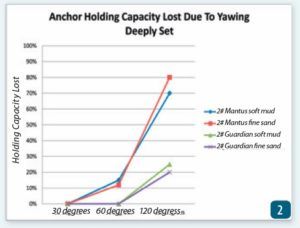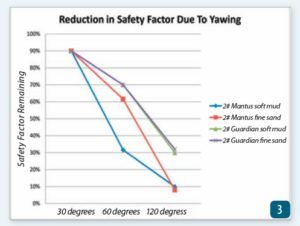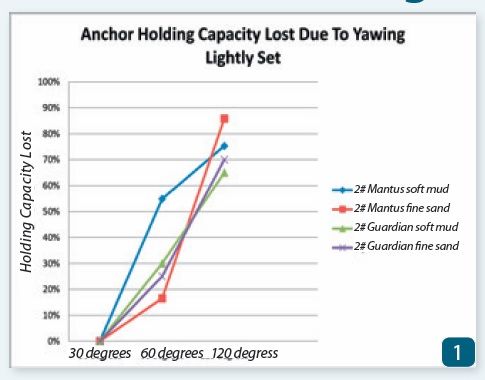© Belvoir Media Group, LLC. All rights reserved.
Setting history matters. If the anchor is deeply set, a good portion of the rode is pulled underground, the anchor is in firmer substrate, and the broad shank is now underground, available to resist any attempt to rotate the anchor. But will it stay deeply set if yawing exceeds 30 degrees? The answer depends on the bottom type, wind strength, and how wild the yawing gets. But it is certainly better than a lightly set anchor, which can start walking in moderate winds with yawing angle of less than 60 degrees.
We then looked at the change in safety factor. Not only is the holding capacity of a walking anchor less, the rode tension on a yawing boat is greater. The reduction in safety factor can be calculated by dividing the percent reduction in holding capacity by the percent increase in rode tension. Why can a yawing boat can drag in a mere 20 knots? Because the safety factor has been reduced by as much as 90 percent!


Related posts: Yawing and Anchor Holding
Taking Our Test Anchors Out for a Wiggle-walk

I learned what you studied from (too many) practical experiences. The remedy, IMHO, is to set a second anchor at a good angle off the bow (60 to 90 degrees) in shifty winds. With this rig, we have weathered a strong Meltemi gusting from different angles when coming around a peak, while in the Aegean, as well as a full gale/small storm while hiding in an cove in Hanish Island in the Red Sea. I have renamed this rig “The Captain Gets To Sleep At Night” rig, as otherwise I was up every 30 minutes checking my GPS track.
Any mention of using two anchors is bound to start a vigorous water cooler debate. Many believe that one large anchor is the right answer all the time. It is simpler, and with modern anchors, they’re right 95% of the time, depending on the location. But there are circumstances where two anchors can really calm things down, and they should not be hard to set or recover, with the right technique and practice. Please read “Doubling Up,” September 2016.